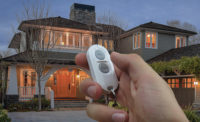
Customers never have to come home to a dark house when the lighting is turned on by this wireless controller.
Widely perceived as a residential crime deterrent, lighting is a natural complement to security. Acadiana Security Plus, Broussard, La., one of this year’s SDM 100 security dealers, started installing lighting systems because a security customer requested it.
Lighting control systems are helping a growing number of security dealers and systems integrators increase profits and revenue by differentiating their businesses, reducing attrition and attracting new customers.
Can adding lighting controls to your business brighten your prospects and profits? Let’s shed some light on questions you may have about offering integrated security and lighting systems.

Scene lighting convenience and aesthetics are key selling points. This control has preset lighting levels for the activities listed.
Why offer lighting control?
Increase profits and revenue.The margin on lighting systems can be 40 percent or higher, which helps security dealers offset the lower margins on security systems.“Dealers can purchase our LiteJet system for under $2,250, install it for about $1,000 and charge an average of $5,000 to $5,500,” remarks Diane Davis, vice president of marketing for CentraLite, Mobile, Ala.
Because lighting systems tend to cost in the thousands instead of the hundreds like security systems, Thomas Pickral Jr., business development manager for HAI, New Orleans, counsels security dealers to get paid for the full cost of lighting equipment upfront instead of discounting it to generate new monthly revenues.
He believes that security dealers typically install lighting control for a one-time charge, and monitoring dealers may add a service contract fee on the lighting system to the customer’s monthly bill.
“Lighting control is profitable,” states Josh Curnel, operations manager for Total Media Designs, Houston, “and it’s becoming a higher portion of our total revenue, because we’ve found a product line that, after a short learning curve, is easy for us to work with.”
Within 18 months, lighting control has grown to account for approximately 15 percent of this security and home automation company’s total revenue.
Attract new business.According to an annual report from the Consumer Electronics Association (CEA) and the National Association of Home Builders (NAHB), lighting control was the fastest growing category of home automation in 2006.
So demand is out there, and it is not just from owners of multimillion-dollar homes. “Baby boomers and Generation Xers are buying technology like crazy,” Pickral reports. “Boomers, our largest base of customers, are moving into smaller homes and have money to invest in home luxuries and technologies.
“The Generation X cohort is doing something unusual — buying technology and their first homes,” Pickral continues. “One way to effectively position the cost of lighting control with these groups is to start with systems whose prices compare to that of a new computer or plasma TV.”
Build repeat business.Grant Sullivan, product marketing manager for Leviton, Little Neck, N.Y., asserts that customers who purchase a lighting control system soon come to think of it as indispensable and contact their installing dealer about expanding the system to more rooms or to the exterior of their home. Total Media Systems’ experience bears this out.
“To avoid scaring customers off because of price, we typically present a $1,500 to $2,000 package of about 10 dimmers,” describes Curnel. “Customers almost always call back wanting more. We then bump them up another 20 to 30 dimmers.”
Cross-sell customers.Kenny Klusman, director of business development for Acadiana Security Plus, notes the company is successful about 80 percent of the time when proposing lighting control to security customers with homes of 6,000 square feet or more.
Retain customers.Purchasing a home security system is similar to buying insurance — you pay for it but hope you never have to use it. The downside is that if it never is used, customers may decide they do not need it.
According to Sullivan, security dealers are finding that tying home automation and lighting control systems into a security system can turn an out-of-sight, out-of-mind system into one that customers use — and see the benefits of — every day.

A customer’s home lighting goals can be achieved with as few as five light zones, so it is easy for dealers to get started in lighting control.
How do I sell it?
Security.Security sells lighting controls. “It’s an easy transition from security to lighting when talking to potential customers,” Curnel says. “Lighting is an easy sell, because they know lighting is one of the best ways to secure a home.”Pickral agrees. “Consumers don’t think they need lighting control, even if they have the money to pay for it,” he reports. “They don’t think they need outside lighting controls, for example. If you tell them that lighting controls will turn on and flash exterior lights if an alarm is triggered, they do think they need it.”
Safety.This is another key benefit. “Lighting systems create a safe pathway of light when customers arrive home,” explains Bart Manguno, security sales supervisor for Lutron, Coopersburg, Pa. “That means they never have to walk into a dark house.”
Another safety feature that piques customers’ interest is that lighting controls enable them to turn on lights at low intensity in a bathroom or hallway in the middle of the night.

Low voltage wires are run to the keypad mudring in new construction.
One way to cut that waste is by controlling the wattage used by light bulbs. According to the LSU project, dimming an incandescent light bulb 10 percent will save 10 percent in electricity and double bulb life.
If a bulb is dimmed 50 percent, the savings are 40 percent, and the light bulb will last 20 times longer! Customers can consider these potential energy savings as an offset to the cost of the lighting control system.
Ambiance.Dimming lights has another benefit for homeowners, which is the ability to set lighting levels and create the ambiance they want for each area of their home.
“This is a benefit consumers only fully realize after they’ve had a lighting system for a while,” notes Manguno. “It’s like realizing how fast broadband Internet access is compared to dial-up. Once you experience it, you don’t want to go back to the old way.”
Convenience and aesthetics.These benefits go hand-in-hand. A master controller can sit on a tabletop or bedside for easy access. Wireless controllers clipped to a car visor or on a keychain enable homeowners to turn on lights when they pull into the driveway.
Scene controllers eliminate the need to flip multiple switches on and off, and they replace clunky banks of switches with a more aesthetically pleasing configuration. Plus, homeowners can pay one bill for security and lighting control and make one phone call if there are problems with either one.
Davis offers dealers this handy mnemonic device for presenting the benefits of lighting control. “Make a C.A.S.E. for lighting,” she describes. “Talk about comfort and convenience, aesthetics, security, energy savings and enhanced property value.”

Like dimmers, occupancy sensors cut energy use and are inexpensive to install.
How do I install it?
“Security dealers think that lighting control installation is hard, but if you can do security, you can do lighting,” Curnel maintains. “There are three steps in lighting control installation — high voltage, low voltage and programming.”High-voltage installation.This step usually is handled by a licensed electrician. The good news is that lighting controls are installed like many other high-voltage components in the home, so they are not difficult or new for electricians.
Curnel says that after watching an electrician install switches a couple of times, “You can do it yourself,” if permitted.
Some dealers work with a builder’s electricians who already are on the job site. They may not even charge for dimmer installation because they have to do that work, anyway.
Other dealers bring in electricians they have developed relationships with and trained to install the systems they sell — with the help of manufacturer- and distributor-provided training and technical support.
Manguno estimates installing the Lutron AuroRA system might take an electrician 30 to 45 minutes. “Dealers can still make $200 to $300 on installation of this system after paying an electrician,” he maintains. “Just crunch the numbers to set your price.”
Some dealers have discovered a bonus associated with establishing relationships with electricians — new business from referrals by those electricians!
Low-voltage installation.This step in installation of the CentraLite LiteJet system, for example, makes up about half of the total installation and will be familiar to security dealers, such as running Cat 5 cable to switch locations in the home. The Lutron AuroRA security system interface requires a single wire.

Thorough lighting control planning with the homeowner upfront can reduce go-back trips.
Lutron has eliminated this phase by preprogramming its AuroRA system. CentraLite does not use the programming word, instead calling this phase “configuration and set-up” because of its Windows-based click-and-drag simplicity. The basic HAI Lumina system can be programmed easily using a keypad — computer software is available for more sophisticated installs.
The Leviton Vizia-RF system is designed to be quick and easy for professional installers. It uses Z-Wave technology to create a wireless mesh network that requires no centralized box. The installer uses a handheld remote with an LCD screen to program each device.
To include a device in the Vizia-RF system, the installer stands about three feet away from it and pushes the “include” button on the remote and on the switch to establish communication between the two.
The installer then can create lighting scenes by pushing a scene controller button on the remote and then pressing the “+” or “-” key to associate specific devices viewed on the LCD screen with that scene.
If your company is ready to begin offering lighting control systems, you have a choice of system complexity. Although you may associate some of these manufacturers with large, sophisticated lighting systems, all of them have been expanding their product lines to include systems that are more affordable for more customers and easier for security dealers of all sizes to sell and install.
Four products are highlighted in the accompanying sidebar, “Growing Choices in Affordable Lighting Controls.” These products, or ones from other manufacturers, can help light up your bottom line.
Sidebar: Growing Choices in Affordable Lighting Controls
To meet demand from a wider buying audience and a growing number of security dealers, lighting control manufacturers have introduced smaller, simpler and more affordable lighting control systems to their product lines that integrate with security systems. For example:CentraLite LiteJet.This system, designed and engineered for new homes in the $350,000 to $1 million range, stores up to 30 lighting scenes, including built-in scenes for all-on, all-off, vacation mode and alarm flash. A real-time astronomical clock can program up to 12 timed events. The system is available through distributors. For more information, visitwww.centralite.com.
HAI Lumina.This scalable product that is based on the universal powerline bus (UPB) is for dealers who want to retrofit security systems they have previously installed with lighting control. It can operate lighting devices by other manufacturers, including Z-Wave-based devices, ALC hardwire, RF and custom hardwire, among others. It is available from distributors. For more information, visitwww.homeauto.com.
Leviton Vizia-RF.This system provides optimal performance for up to 72 devices in homes of 7,500 square feet or less. It uses embedded Z-Wave radio frequency technology and features enhanced two-way control, scene and zone control and remote control operation. The system is sold through distributors. For more information, visitwww.leviton.com.
Lutron AuroRA.An RF-based system, AuroRA offers five zones of light in a packaged, preprogrammed system that works “right out of the box” and is designed to be installed in less than an hour. It is specifically designed for security dealers who never have offered lighting control and want to expand their product offerings. The system is available from distributors. For more information, visitwww.lutron.com.
Sidebar: Tips for Success
Get the training.“Whatever product line you pick, go to the training and get certified,” advises Josh Curnel, operations manager for Total Media Designs, Houston. Although he admits a wealth of installation support and information is available online and in manuals, Curnel thinks doing this is the best way to start.Think small.Are you hesitant or unsure about lighting control? Develop your expertise and find out if you like this product category by offering smaller systems, perhaps in retrofit instead of new construction projects. Smaller systems also can be easier to sell to homeowners who are not sure they want lighting control.
Start with one switch per room or in an area where lighting will have the strongest impact on security and lifestyle, such as the kitchen, bedrooms, hallways, home theater and front porch. The cost will be lower and, experience shows, homeowners are likely to want an expanded system once they see the benefits for themselves. “Customers call us all the time to add more lighting controls,” Curnel reports.
Do your homework.“The more time you spend upfront, planning the lighting control layout and system with your customer, the less work and problems you’ll have on the back end,” notes Kenny Klusman, director of business development for Acadiana Security Plus, Broussard, La.
Plan for the future.Always ask suppliers how well a lighting control system works with security and other home technology systems today and if the system can be expanded in the future. The last thing you need is a happy customer who wants more lighting control locations in their home that the system you installed will not allow you to provide.
Sell your customers.“Security dealers are in regular contact with their customers via billing statements, so capitalize on that familiarity,” Pickral recommends. “Put a flyer in the envelope about lighting control and how it can add to the security of their home and family. Dealers tell us they get better response to this form of advertising than any other.”





_feature.jpg?height=200&t=1366253657&width=200)


